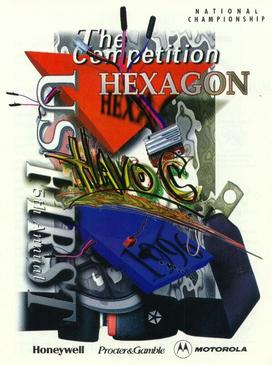
FIRST Frenzy: Raising the Bar was the 2004 game for the FIRST Robotics Competition. The game included elements from previous years' games, including mobile goals, "capping" goals with large inflatable balls, and others. In Raising the Bar, teams could score by having their human player score purple balls in any of the goals, capping the goals with a multiplier ball, or hanging their robot suspended from the 10-foot (3.0 m) high 'chin up bar'. In the qualifying matches, Teams competed in 2-member randomly generated alliances. In the elimination rounds, 3-member alliances competed against each other with one team sitting out each match. The alliance that won two matches advanced in the tournament.

Stack Attack was the game for the 2003 FIRST Robotics Competition. Two teams of two robots compete by moving large Sterilite bins into their zones and arranging them into stacks.

Aim High was the 2006 game for the FIRST Robotics Competition. The competition involved teams competing to gain points by delivering balls into goals and positioning their robots in certain positions on the playing field. The teams took it in turn to provide defense and attack.

Triple Play was the name of the 2005 season FIRST Robotics Competition game.

Zone Zeal was the 2002 game for the FIRST Robotics Competition. In it, robots playing in alliances of two competed to move goals and balls into various zones within the playing field.

Hexagon Havoc was the 1996 game for the FIRST Robotics Competition. Seeding games of 1-on-1-on-1 were played double-elimination to determine the teams for the finals rounds. In the finals, robots played 1-on-1 in a best 2 out of 3.

Toroid Terror was the 1997 game for the FIRST Robotics Competition. This was the first year that FRC had a regional event outside its origins in New Hampshire; in addition to Manchester, regionals were held in Chicago and New Brunswick, New Jersey, as well as the championship event at a complex set up in the Epcot parking lot. It was also the first year in which the scoring object was not a ball.

Ladder Logic was the game for the 1998 FIRST Robotics Competition.

Double Trouble was the 1999 game for the FIRST Robotics Competition, and the first game to feature alliances.

Co-Opertition FIRST was the 2000 game for the FIRST Robotics Competition.

Rack 'n Roll was the game for the 2007 FIRST Robotics Competition season, announced on January 6, 2007. In it, two alliances of three teams each competed to arrange ring-shaped game pieces on a central arena element known as 'The Rack'.

Half-Pipe Hustle was the first official FIRST Vex Challenge (FVC) game, taking place in 2005–2006. In this challenge, robotics teams built robots from the Vex design kit to compete in competitions across the United States and in other nations, in matches consisting of a 45-second autonomous period, followed by a 2-minute driver control period in which the robots are controlled by team drivers using remote controls.

Lunacy is the game for the 2009 FIRST Robotics Competition. Announced on January 3, 2009, the name and some of the features of the game honor the 40th anniversary of the first human mission to the Moon. It is FRC's 18th game. This is the first FRC competition to use the cRIO Mobile Device Controller control system from National Instruments. The driver station introduced for 2009 was the Kwikbyte DS, which was replaced in 2010 by the Classmate PC.

Hot Shot! is the robotics competition event in the 2009-2010 FIRST Tech Challenge. Two teams compete to score points by depositing whiffle balls into designated areas.
Breakaway is the game for the 2010 FIRST Robotics Competition, announced on January 9, 2010. Robots direct soccer balls into goals, traverse "bumps" in the field, suspend themselves and each other on towers, and/or go through a tunnel located in the center of the field.

Bowled Over!, released on 10 September 2011, is the 2011–12 robotics competition for FIRST Tech Challenge. Two alliances compete to score racquetballs into alliance-colored scoring goals. The name refers to two bowling balls on the field used for scoring points.
FIRST Stronghold was the 2016 FIRST Robotics Competition game. The game was played by two alliances of up to three teams each, and involves breaching the opponents’ defenses, known as outer work as well as capturing their tower by first firing "boulders" at it, and then surrounding or scaling the tower using a singular rung on the tower wall. Points were scored by crossing elements of the tower's outer works, shooting boulders into the opposing tower's five goals in order to lower the tower strength, and by surrounding and scaling the tower.
VEX Robotics is a robotics program for elementary through university students and a subset of Innovation First International. The VEX Robotics competitions and programs are managed by the Robotics Education & Competition Foundation (RECF). In April 2018, VEX Robotics Competition was named the largest robotics competition in the world by Guinness World Records.

Destination: Deep Space, stylized as DESTINATION: DEEP SPACE and officially known as Destination: Deep Space Presented By The Boeing Company, is the FIRST Robotics Competition game for the 2019 season. It involves two alliances of three teams each, with each team controlling a robot and performing specific tasks on a field to score points. The game centers around an outer space theme involving two alliances consisting of three teams each competing to place poly-carbonate hatch panels and orange rubber balls or "cargo" on rockets and cargo ships before returning to their HAB platform to climb at the end of the match.

Infinite Recharge is the FIRST Robotics Competition (FRC) game for the 2020 season. The season is in partnership with Lucasfilm as part of its Star Wars: Force for Change initiative.


















